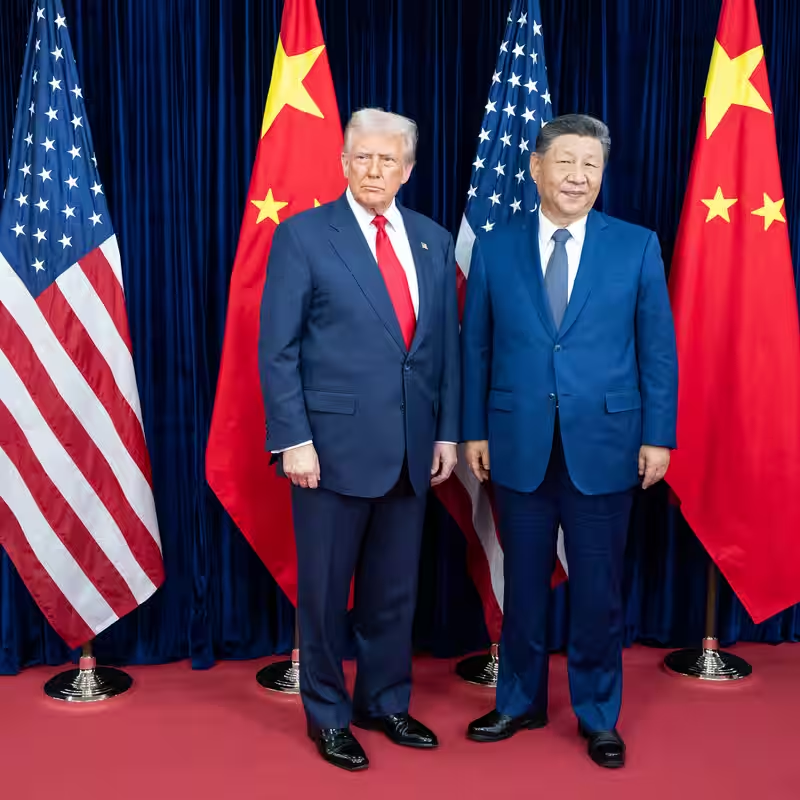Table of Contents
- A Fragile Trade Truce
- Trump’s Shocking Nuclear Testing Announcement
- Rare Earths, Fentanyl, and Farm Exports
- What Was Left Unsaid: Taiwan and Ukraine
- Asia Reacts: Japan, South Korea Step Up Defense
- Sources
Trump-Xi Deal Eases Trade War—But Sparks Nuclear Fears
In a high-stakes summit in Busan, South Korea, President Donald Trump and Chinese leader Xi Jinping struck a surprising agreement to de-escalate their long-running trade war—at least temporarily. The deal, described by Trump as a “12 out of 10,” includes a one-year pause on tariffs, rare earth export restrictions, and fentanyl-related trade penalties.
Yet, just hours before the meeting, Trump sent global markets and security analysts into a tailspin with an unexpected social media post: the U.S. would resume nuclear weapons testing for the first time in over 30 years.
Trump’s Shocking Nuclear Testing Announcement
“Because of other countries testing programs, I have instructed the Department of War to start testing our Nuclear Weapons on an equal basis,” Trump wrote on Truth Social.
While he later claimed the move wasn’t aimed at China—refusing to name the “other countries”—the timing couldn’t have been more provocative. The announcement followed Russian President Vladimir Putin’s recent tests of a nuclear-capable missile and a sea-based nuclear drone capable of triggering tsunamis.
China, meanwhile, is undergoing one of the fastest nuclear arsenal expansions in modern history. Though Trump insisted the U.S. has “it pretty well locked up,” experts warn the resumption of testing could ignite a new arms race.
Rare Earths, Fentanyl, and Farm Exports
Despite the nuclear backdrop, the economic outcomes of the summit were concrete:
- Rare Earth Metals: China agreed to suspend export curbs for one year—critical for U.S. tech and defense manufacturing.
- Fentanyl Crackdown: Beijing pledged stronger controls on precursor chemicals; in return, the U.S. slashed fentanyl-linked tariffs from 20% to 10%.
- Agricultural Boom: Trump claimed China committed to buying “massive amounts of soybeans” and other farm goods, cheering American farmers.
- Energy Deals: China will “begin the process” of purchasing U.S. energy products, though specifics remain vague.
What Was Left Unsaid: Taiwan and Ukraine
Notably absent from the agenda? Taiwan. When asked, Trump admitted the issue “did not come up.” This silence speaks volumes, given China’s increasing military pressure on the self-governed island.
On Ukraine, Trump said he and Xi discussed “working together” to end the war—but sidestepped questions about China’s ongoing purchases of Russian oil, which fund Moscow’s invasion.
Asia Reacts: Japan, South Korea Step Up Defense
Trump’s Asia tour wasn’t just about China. In Tokyo, he announced Japan would arm its fighter jets with U.S.-made missiles. In Seoul, he greenlit South Korea’s development of a nuclear-powered submarine—a major shift in non-proliferation policy.
These moves signal a broader U.S. strategy: bolster Indo-Pacific allies to counterbalance Beijing’s influence, even as trade tensions ease.
What Comes Next?
Trump plans to visit China in April 2026, calling the relationship “very, very important.” But with nuclear testing back on the table and geopolitical fault lines deepening, the truce may be more fragile than it appears.
Sources
The New York Times: Trump and Xi Ease Off the Trade War, but New Nuclear Threat Brings a Chill




